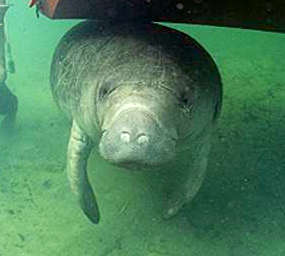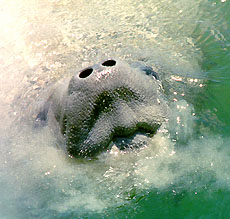|
| 
The Gentle Creature, the ManateeFor the past several weeks, Reef Brief has covered the ecological importance of ecosystems such as mangroves, sea grass beds, lagoons, and wetlands. One of the most docile and rare of marine mammals, the West Indian manatee (Trichechus manatus manatus), is very dependent on these habitats for feeding and breeding and here it finds a refuge in the absence of aggressive predators. Despite its attempts to evade predators, the manatee, perhaps the most famous of Belize's marine mammals, still finds itself listed as Vulnerable by the World Conservation Union. Hard to mistake, the manatee is characterized by a large, seal-like body that tapers to a spatulate tail. Distinguished by features of thick and gray or gray-brown wrinkled skin and stiff whiskers on its upper lip, it's not surprising that the manatee's closest relative is the elephant. Manatees are part of a group called Sirenia, because of their relation with the mythical "Sirena" (mermaids). The Sirenians have the distinction of being the only herbivorous (plant eating) aquatic animals. Manatees eat a variety of floating, submerged and bottom growing aquatic plants, such as seagrasses, algae, and mangrove leaves. Of ecological importance, manatees are responsible for recycling of nutrients between the water column and the substrate (mud, sand, rock).
 Along the mainland coasts of the Caribbean, the Atlantic coast of
Mexico, and northern countries of South America lies the range of the West
Indian manatee. Other than the seasonal movements to warm waters for it's
survival, the manatee has very little pattern to its life cycle. Calves are
born every two to five years after a 13-month gestation period, and remain
dependent on their mothers for two years. The population of manatees in
Belize has varied over the past decade, but is now estimated at 300-700
individuals. Despite this seemingly low number, Belize is thought to have
the highest concentration of this subspecies in the world. However, the
current population is significantly lower than a century ago and is
continuing to decline. What is causing the West Indian manatee to hover near
extinction?
Along the mainland coasts of the Caribbean, the Atlantic coast of
Mexico, and northern countries of South America lies the range of the West
Indian manatee. Other than the seasonal movements to warm waters for it's
survival, the manatee has very little pattern to its life cycle. Calves are
born every two to five years after a 13-month gestation period, and remain
dependent on their mothers for two years. The population of manatees in
Belize has varied over the past decade, but is now estimated at 300-700
individuals. Despite this seemingly low number, Belize is thought to have
the highest concentration of this subspecies in the world. However, the
current population is significantly lower than a century ago and is
continuing to decline. What is causing the West Indian manatee to hover near
extinction?Reports of declining manatee populations due to hunting date back to 1883. In spite of the Manatee Protection Ordinance of 1935 and the more recent protection under the Wildlife Protection Act, illegal hunting has persisted. Reports of manatee bones at butcher sites is evidence that manatees are still taken for local consumption, especially in Southern Belize, but currently the primary threat is the exportation of meat to neighboring countries such as Honduras and Guatemala. Another threat exists in boat collisions with manatees; propeller-scarred manatees are becoming an increasingly common site. Moreover, as boat traffic increases, manatees are left with fewer undisturbed creeks and channels for calving and resting areas, thus they are forced to seek out less suitable habitats to avoid such harassment. In the search for habitat, manatees often find themselves susceptible to entrapment and death due to gill netting in rivers and across river mouths. Finally, it should come as no surprise that industrial and agricultural pollution, as well as effluent from domestic sewage, adversely affects the health of manatees and potentially destroys the vegetation on which they feed. Increased coastal development has made this a significant threat. It seems that with such a high number of threats, the manatee has an uphill battle for survival. Fortunately, over the past decade, the people of Belize have made great strides in preventing further loss of this species. Public awareness campaigns and educational workshops have helped to increase enforcement of regulations. Still, more enforcement is needed to protect this species, whose fate hangs in the balance. Check out Reef Brief next week to find out more about the sea turtles of Belize.
|
 Copyright by Casado Internet Group, Belize |